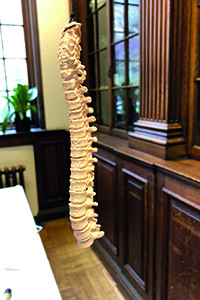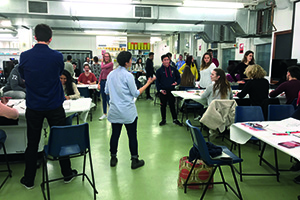Synthetic anatomy
Synthetic Anatomy brings together Biomedical and Engineering students to explore evolution and pathology through 3D-print design and art studio practices.
Synthetic Anatomy explored the impact of arts engagement on students’ attitudes to risk, cross-disciplinary collaboration and creative and intellectual autonomy.

In a classroom newly equipped with 3D printers and collaboration tables, students from the departments of Anatomy and Biomedical Engineering worked in cross-disciplinary groups to develop and document a 3D printing project under the guidance and supervision of artist-tutors.
Traditional art techniques were blended with science, medicine and technology as students printed mini 3D models of aortas to scale from real patient data, recorded, analysed and made stories from fragments of cloth and measuring instruments, and learned to be freer in their sketch-book work by cutting them up.
The newly refurbished classroom fostered a new kind of learning dynamic, positioning staff and students as peers with a shared passion for their subject. The artist-led workshops bought valuable creative practices into the science curriculum: supporting idea generation and risk-taking through sketchbook development, directed play, reflection, presentation, group criticism and written portfolios. This process-led, collaborative model of education also encouraged learning from unexpected outcomes and placed value on personal investment and team work.
 This approach was crucial in supporting the module learning outcomes, which include the ability to critically review structural, functional, developmental and evolutionary relationships within Anatomy; to reflect on effective strategies for collaborative research; to deliver and utilise constructive feedback; and to summarise and present learning to peers and tutors.
This approach was crucial in supporting the module learning outcomes, which include the ability to critically review structural, functional, developmental and evolutionary relationships within Anatomy; to reflect on effective strategies for collaborative research; to deliver and utilise constructive feedback; and to summarise and present learning to peers and tutors.
Students fed back that they valued the freedom to devise their own project, think for themselves and be creative.
One remarked that, ‘The art sessions challenged us to think in a completely different way and I hated it at first and felt uncomfortable, but towards the end I realised that I never ever have thought of things this way in life and I enjoyed it.’
Their experiences were reflected in the students’ final project displays which were, in the words of Module Lead, Richard Wingate, ‘an explosion of creativity and industry that far exceeded our expectations.’
Conclusions
The module fostered a high-level of energy and commitment among the students, many of whom arrived early and stayed late, even at the end of a Friday afternoon teaching session.
The authenticity of the projects was noted by the students who were able to see how the process of collaborative design, documentation, critical reflection and presentation would relate to future employment situations.
Dr. Richard Wingate, Reader of Developmental Neurobiology, in collaboration with artists Celia Pym, Shelley James, Les Bicknell and Andrew Carnie.